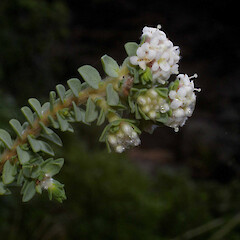Pimelea urvilleana subsp. urvilleana
Common name
pinātoro
Synonyms
Pimelea urvilliana A.Rich. subsp. urvilliana other. var.; Pimelea urvilliana A.Rich. orth. var.; Pimelea prostrata var. urvilleana (A. Rich.)
Family
Thymelaeaceae
Flora category
Vascular – Native
Endemic taxon
Yes
Endemic genus
No
Endemic family
No
Structural class
Trees & Shrubs - Dicotyledons
Chromosome number
2n = 36
Current conservation status
The conservation status of all known New Zealand vascular plant taxa at the rank of species and below were reassessed in 2017 using the New Zealand Threat Classification System (NZTCS) – more information about this can be found on the NZTCS website. This report includes a statistical summary and brief notes on changes since 2012 and replaces all previous NZTCS lists for vascular plants.
Please note, threat classifications are often suggested by authors when publications fall between NZTCS assessment periods – an interim threat classification status has not been assessed by the NZTCS panel.
- Conservation status of New Zealand indigenous vascular plants, 2017 . 2018. Peter J. de Lange, Jeremy R. Rolfe, John W. Barkla, Shannel P. Courtney, Paul D. Champion, Leon R. Perrie, Sarah M. Beadel, Kerry A. Ford, Ilse Breitwieser, Ines Schönberger, Rowan Hindmarsh-Walls, Peter B. Heenan and Kate Ladley. Department of Conservation. Source: NZTCS and licensed by DOC for reuse under the Creative Commons Attribution 4.0 International licence.
2017 | Not Threatened
Previous conservation statuses
2012 | Data Deficient
2009 | Not Threatened
2004 | Not Threatened
Brief description
Very low-growing sprawling shrub with densely white-hairy twigs bearing clustered pairs of thick blue-green leaves, hairy white flowers and white fruit inhabiting coastal areas south to Nelson. Leaves 3-6mm long by 2-3mm, underside shiny.
Distribution
Endemic. North Island: widespread, often common from Three Kings, throughout coastal Northland, thence mostly easterly south to the Wairarapa and south Taranaki. South Island: Tasman Bay (Astrolabe Passage), Marlborough Sounds.
Habitat
Coastal. Rock outcrops, cliffs, sometimes in scrub.
Detailed description
A small to medium-sized prostrate shrub; stems moderately stout but flexible, up to 300 mm long. Branching notably sympodial with some laterals. Branchlets densely covered by matted white hair. Internodes 1–3 mm long. Older stems slightly hairy, grey-brown. Node buttresses smooth, black, lunate, masked by hair on young stems. Leaves decussate but usually distichously arranged, ascendant on youngest branchlets, patent later. Lamina 3–6 × 2–3 mm, thick, narrow-elliptic to ovate, flat or slightly keeled. Tip usually obtuse. Stomata abundant adaxially, none or rare abaxially. Abaxial surface glistens. Inflorescences 5–7-flowered compact, receptacles very hairy. Involucral bracts 4, similar in size to adjacent leaves. Plants gynodioecious. Flowers small, white, outside very hairy, inside sparsely hairy in upper tube. Calyx lobes opening in salverform fashion or ascendant. Female tube 1.8 mm long, ovary portion wrinkled, 1.5 mm, calyx lobes 1.2 × 1 mm. hermaphrodite tube 3.8 mm long, ovary portion 2.5 mm, calyx lobes 2 × 1.5 mm. Anther dehiscence semi-latrorse. Ovary with a tuft of long hair on summit. Fruits white, fleshy, opaque 5 × 3.5 mm. Seeds broad ovoid 3 × 1.8 mm.
Similar taxa
See Pimelea urvilleana subsp. nesica. Description from: Burrows, C.J. 2009: Genus Pimelea (Thymelaeaceae) in New Zealand 2. The endemic Pimelea prostrata and Pimelea urvilliana species complexes. New Zealand Journal of Botany 47: 163–229.
Flowering
Unknown. Burrows (2009) states: Summer
Flower colours
White
Fruiting
Unknown.
Propagation technique
Probably easily grown from semi-hardwood cuttings and rooted pieces. As with other pimelea seed is probably difficult to germinate.
Threats
See notes
Etymology
pimelea: Pimeleoides means “resembling Pimelea’’, a genus in the family Thymelaeaceae (Greek, -oides = resembling, like).
urvilleana: After D’Urville Island, which is named in honour of Jules Sébastien César Dumont d’Urville (23 May 1790 - 8 May 1842) - a French explorer, naval officer and rear admiral, who explored the south and western Pacific, Australia, New Zealand and Antarctica.
Where To Buy
Probably not commercially available
Notes on taxonomy
Burrows (2009) offers a very clear (for the first time ever for this species) interpretation of Pimelea urvilleana, and as such splits it into two subspecies. Based on that interpretation he argues that P. urvilleana subsp. urvilleana is close to if not already extinct. However, it is stated that the genome survives in hybrids. No evidence is provided to back that claim up beyond empirical observations and some minor morphological assessments of herbarium material. Subsequent field work has shown that Pimelea urvilleana subsp. urvilleana is widespread, often common and not threatened. The distinctions offered for Pimelea urvilleana subsp. nesica seem dubious especially as specimens with characters of both subspecies can be found on the same plant.
Attribution
Fact sheet prepared by P.J. de Lange (17 October 2009). Description adapted from Burrows (2009).
References and further reading
NZPCN Fact Sheet citation
Please cite as: de Lange, P.J. (Year at time of access): Pimelea urvilleana subsp. urvilleana Fact Sheet (content continuously updated). New Zealand Plant Conservation Network. https://www.nzpcn.org.nz/flora/species/pimelea-urvilleana-subsp-urvilleana/ (Date website was queried)







